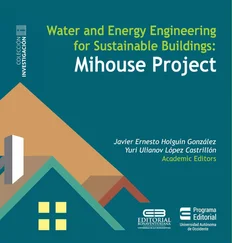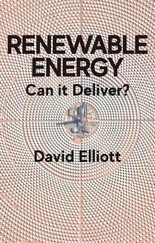Rodolfo Araneo - Electrical Safety Engineering of Renewable Energy Systems
Здесь есть возможность читать онлайн «Rodolfo Araneo - Electrical Safety Engineering of Renewable Energy Systems» — ознакомительный отрывок электронной книги совершенно бесплатно, а после прочтения отрывка купить полную версию. В некоторых случаях можно слушать аудио, скачать через торрент в формате fb2 и присутствует краткое содержание. Жанр: unrecognised, на английском языке. Описание произведения, (предисловие) а так же отзывы посетителей доступны на портале библиотеки ЛибКат.
- Название:Electrical Safety Engineering of Renewable Energy Systems
- Автор:
- Жанр:
- Год:неизвестен
- ISBN:нет данных
- Рейтинг книги:5 / 5. Голосов: 1
-
Избранное:Добавить в избранное
- Отзывы:
-
Ваша оценка:
- 100
- 1
- 2
- 3
- 4
- 5
Electrical Safety Engineering of Renewable Energy Systems: краткое содержание, описание и аннотация
Предлагаем к чтению аннотацию, описание, краткое содержание или предисловие (зависит от того, что написал сам автор книги «Electrical Safety Engineering of Renewable Energy Systems»). Если вы не нашли необходимую информацию о книге — напишите в комментариях, мы постараемся отыскать её.
A reference to designing and developing electrical systems connected to renewable energies Electrical Safety Engineering of Renewable Energy Systems
Electrical Safety Engineering of Renewable Energy Systems
Electrical Safety Engineering of Renewable Energy Systems — читать онлайн ознакомительный отрывок
Ниже представлен текст книги, разбитый по страницам. Система сохранения места последней прочитанной страницы, позволяет с удобством читать онлайн бесплатно книгу «Electrical Safety Engineering of Renewable Energy Systems», без необходимости каждый раз заново искать на чём Вы остановились. Поставьте закладку, и сможете в любой момент перейти на страницу, на которой закончили чтение.
Интервал:
Закладка:
Electrical Safety Engineering of Renewable Energy Systems
Rodolfo Araneo
University of RomeRome, Italy
Massimo Mitolo
Irvine Valley College Irvine, California

This edition first published 2022
© 2021 John Wiley & Sons, Ltd.
© 2022 by The Institute of Electrical and Electronics Engineers, Inc. All rights reserved.
Published by John Wiley & Sons, Inc., Hoboken, New Jersey.
Published simultaneously in Canada.
No part of this publication may be reproduced, stored in a retrieval system, or transmitted in any form or by any means, electronic, mechanical, photocopying, recording, scanning, or otherwise, except as permitted under Section 107 or 108 of the 1976 United States Copyright Act, without either the prior written permission of the Publisher, or authorization through payment of the appropriate per-copy fee to the Copyright Clearance Center, Inc., 222 Rosewood Drive, Danvers, MA 01923, (978) 750-8400, fax (978) 750-4470, or on the web at www.copyright.com. Requests to the Publisher for permission should be addressed to the Permissions Department, John Wiley & Sons, Inc., 111 River Street, Hoboken, NJ 07030, (201) 748-6011, fax (201) 748-6008, or online at http://www.wiley.com/go/permission.
Limit of Liability/Disclaimer of Warranty: While the publisher and author have used their best efforts in preparing this book, they make no representations or warranties with respect to the accuracy or completeness of the contents of this book and specifically disclaim any implied warranties of merchantability or fitness for a particular purpose. No warranty may be created or extended by sales representatives or written sales materials. The advice and strategies contained herein may not be suitable for your situation. You should consult with a professional where appropriate. Neither the publisher nor author shall be liable for any loss of profit or any other commercial damages, including but not limited to special, incidental, consequential, or other damages.
For general information on our other products and services or for technical support, please contact our Customer Care Department within the United States at (800) 762-2974, outside the United States at (317) 572-3993 or fax (317) 572-4002.
Wiley also publishes its books in a variety of electronic formats. Some content that appears in print may not be available in electronic formats. For more information about Wiley products, visit our web site at www.wiley.com.
Library of Congress Cataloging-in-Publication Data
Names: Araneo, Rodolfo, author. | Mitolo, Massimo A. G., author. | John
Wiley & Sons, publisher.
Title: Electrical safety engineering of renewable energy systems / Rodolfo
Araneo, Massimo Mitolo.
Description: Hoboken : John Wiley & Sons, 2022. | Includes bibliographical
references and index.
Identifiers: LCCN 2021025391 (print) | LCCN 2021025392 (ebook) | ISBN
9781119624981 (hardback) | ISBN 9781119624998 (pdf) | ISBN 9781119625018 (epub)
| ISBN 9781119625056 (ebook)
Subjects: LCSH: Electric apparatus and appliances--Safety measures. |
Renewable energy sources--Safety measures.
Classification: LCC TK152 .A73 2022 (print) | LCC TK152 (ebook) |
DDC 621.3028/9--dc23
LC record available at https://lccn.loc.gov/2021025391
LC ebook record available at https://lccn.loc.gov/2021025392
Cover image: © oxygen/Getty
Cover design by Wiley
Set in 9.5/12.5pt STIXTwoText by Integra Software Services, Pondicherry, India.
Contents
1 Cover
2 Title page Electrical Safety Engineering of Renewable Energy Systems Rodolfo Araneo University of RomeRome, Italy Massimo Mitolo Irvine Valley College Irvine, California
3 Copyright
4 Preface
5 Acknowledgments
6 1 Fundamental Concepts of Electrical Safety Engineering 1.1 Introduction1.2 Electric Shock1.2.1 Ventricular Fibrillation1.2.2 The Heart-current Factor1.3 The Electrical Impedance of the Human Body1.3.1 The Internal Resistance of the Human Body1.4 Thermal Shock1.5 Heated Surfaces of Electrical Equipment and Contact Burn Injuries1.6 Ground-Potential and Ground-Resistance1.6.1 Area of Influence of a Ground-electrode1.7 Hemispherical Electrodes in Parallel1.8 Hemispherical Electrodes in Series1.9 Person’s Body Resistance-to-ground and Touch Voltages1.10 Identification of Extraneous-Conductive-Parts1.11 Measuring Touch Voltages
7 2 Safety-by-Design Approach in AC/DC Systems 2.1 Introduction2.2 Class I PV Equipment2.3 Class II PV Equipment2.4 Ground Faults and Ground Fault Protection2.5 Functionally Grounded PV Systems2.6 Non-Ground-Referenced PV Systems2.7 Ground-Referenced PV Systems2.8 Fire Hazard in Ground-Referenced PV Systems2.9 Faults at Loads Downstream the PV Inverter in Ground-Referenced PV Systems2.10 Non-Electrically Separated PV System2.11 PV Systems Wiring Methods and Safety2.12 d.c. Currents and Safety2.13 Electrical Safety of PV Systems2.14 Rapid-Shutdown of PV Arrays on Buildings2.15 Hazard and Risk
8 3 Grounding and Bonding 3.1 Introduction3.2 Basic Concepts of Grounding Systems: The Ground Rod3.3 The Maxwell Method3.4 Multiple Rods: Mutual Resistance3.5 Ground Rings and Ground Grid3.6 Complex Arrangements: Rings and Ground Grids Combined with Rods and Horizontal Electrodes
9 4 Lightning Protection Systems4.1 Review of Natural Lightning Physics, Modeling and Protection4.2 Lightning Protection of PV Systems4.2.1 Ground-Mounted PV Systems4.2.2 Rooftop Mounted PV Systems4.2.3 Protection against Overvoltage4.2.4 Surge Protective Devices (SPDs)4.3 Lighting Protection of Wind Turbines4.3.1 Lightning Protection System (LPS)4.3.2 Step and Touch Voltages4.3.3 Lightning Exposure Assessment4.3.4 Assessment of the Average Annual Number of Dangerous Events N LDue to Flashes Directly to and near Service Cables4.3.5 Lightning Protection Zones4.4 High-Frequency Grounding Systems 4.4.1 Arrangement of Ground Electrodes4.4.2 Effective Length of a Ground Electrode4.4.3 Frequency-dependent Soil and Ionization
10 5 Renewable Energy System Protection and Coordination 5.1 Introduction5.2 Power Collection Systems5.3 Cable Connections5.4 Offshore Wind Farm5.5 Distributed Energy Resources: Battery Energy Storage Systems and Electric Vehicles
11 6 Soil Resistivity Measurements and Ground Resistance 6.1 Soil Resistivity Measurements6.2 Wenner Method6.3 Schlumberger Method6.4 Multi-layer Soils6.4.1 Ground Grid in Multi-layer Soil6.4.2 Ground Rod in Multi-layer Soil6.5 Fall-of-Potential Method for Ground Resistance Measurement6.6 Slope Method for Grounding Resistance Measurement6.7 Star-delta Method for Grounding Resistance Measurement6.8 Four Potential Method for Grounding Resistance Measurement6.9 Potentiometer Method for Grounding Resistance Measurement
12 Appendix 1: Performance of Grounding Systems in Transient Conditions 1 Grounding System Analysis2 Mathematical Model3 Computation of Impedances4 Green’s Function4.1 Static Formulation4.1.1 One-Layer Ground4.1.2 Two-Layer Ground4.2 Dynamic Formulation4.2.1 Equivalent Transmission Line Approach5 Numerical Integration Aspects5.1 Singular Term5.2 Sommerfeld Integrals
13 Appendix 2: Cable Failures in Renewable Energy Systems 1 Cable Failures in Renewable Energy Systems: Introduction2 Possible Solutions2.1 Optimal Solutions2.2 Termite Attacks Prevention3 Non-destructive Methods for Cable Testing and Fault-locating3.1 Insulation Resistance (IR) Test3.1.1 IR Measurement of the Cable Insulation (XLPE)3.1.2 IR Measurement of the Polyethylene (PE) Cable Jacket3.2 High-Potential Test3.3 LCR Test3.3.1 Insulation Resistance (IR)3.3.2 Dielectric Absorption Ratio (DAR)3.3.3 Polarization Index (PI)3.3.4 Quality Factor (Q)3.3.5 Dissipation Factor (DF)3.3.6 Time Domain Reflectometry (TDR) Test3.3.7 Arc Reflection (ARC) Test3.3.8 Bridge Methods3.4 Cable Fault Analysis3.4.1 Prelocation3.4.2 Pinpointing4 Sheath and Jacket Repairs5 Termite Baiting Stations and Monitoring6 Termite-proof Cables
Читать дальшеИнтервал:
Закладка:
Похожие книги на «Electrical Safety Engineering of Renewable Energy Systems»
Представляем Вашему вниманию похожие книги на «Electrical Safety Engineering of Renewable Energy Systems» списком для выбора. Мы отобрали схожую по названию и смыслу литературу в надежде предоставить читателям больше вариантов отыскать новые, интересные, ещё непрочитанные произведения.
Обсуждение, отзывы о книге «Electrical Safety Engineering of Renewable Energy Systems» и просто собственные мнения читателей. Оставьте ваши комментарии, напишите, что Вы думаете о произведении, его смысле или главных героях. Укажите что конкретно понравилось, а что нет, и почему Вы так считаете.












